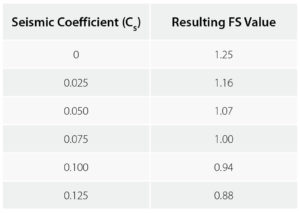In formulating a factor-of-safety value for a mechanically stabilized earth (MSE) wall or slope project, a design engineer calculates a ratio of resisting forces to driving forces. This contrast is further recognized when using load and resistance factor design (LRFD), which is in our not-too-distant future.
The resisting forces are the soil’s inherent properties (e.g., shear strength) and the geosynthetic’s actual properties (e.g., tensile strength). In my opinion, these properties can be determined via simulated laboratory testing per American Society of Testing and Materials (ASTM), International Standards Organization (ISO) or Geosynthetic Research Institute (GRI) standards. Even if an engineer designs on a probability-of-failure hypothesis (Duncan 2000), the statistical variations within the required performance tests (e.g., wide-width tensile and direct shear) are well established. (Koerner and Koerner 2002 has a proficiency test program with a wealth of such data.)
The required forces are the focus of this column, and they can be subdivided into dead and live loads. The dead loads are typically gravitational forces created by the mass of involved soil, and they are deterministic. The live loads, however, are a different set of circumstances, and subjective estimates are often necessary. I will comment on three live-load situations: surcharge loads, hydrostatic loads and seismic loads.
Most MSE wall and slope situations have a surcharge load at or near their crest. Building loads are generally known, but temporary live loads from oversized stationary vehicles, unanticipated storage of products or materials, stockpiled snow/ice and even construction of unanticipated swimming pools have caused problems before. A conservative selection of such surcharge loads anticipating all aspects of long-term use of the site is necessary.
Hydrostatic loads require careful deliberation in their selection since intense storms have caused wall, slope, veneer stability and waste stability failures. Hurricanes, cyclones and other intense weather situations occur today with greater frequency than in the past. Clearly, coastal communities and coastal infrastructure have seen their share of problems, with recent hurricanes in New Jersey, Florida and Texas causing multiple slope failures. In this regard, one wonders if a design engineer should select the 50-year, 100-year or most probable precipitation; furthermore, how good are these established values in an age of extreme weather events?
 The selection of a seismic load in earthquake-prone areas is critically important in calculating factor-of-safety (FS) values. The following table shows the factor-of-safety variation of a 98-foot (30-m) long veneer cover soil using different seismic coefficient (Cs) values.
The selection of a seismic load in earthquake-prone areas is critically important in calculating factor-of-safety (FS) values. The following table shows the factor-of-safety variation of a 98-foot (30-m) long veneer cover soil using different seismic coefficient (Cs) values.
In all three of these situations, illustrating appropriate live-load selection, the significance to design engineers is heightened by the legal decision in Italy, as reported in The Economist in 2012. No additional commentary is necessary, although six of the seven accused were eventually acquitted.
In Italy, sloppy seismology can lead to prison
The earthquake that destroyed L’Aquila, a city in central Italy, on April 6th 2009 killed 309 people at the time. But it took until October 22nd of 2012 for it to claim its latest casualties. Those casualties were seven men (three seismologists, two engineers, a volcanologist and a public official) convicted on that day of manslaughter, for misleading L’Aquila’s inhabitants about the risks they faced. Each was sentenced to six years in prison, though that may be reduced on appeal.
References
Duncan, J. M. (2000). “Factors of safety and reliability in geotechnical engineering.” Jour., Geotechnical and Geoenvironmental Engineering, 126(4), 307–316.
Koerner, R. M., and Koerner, G. R. (2002). “Beyond factor of safety: The probability of failure.” Proc., 16th Geosynthetic Research Institute Conf., GRI Publishers, Folsom, PA, 1–18.
“A reason to tremble.” (2012). The Economist, Oct. 27, 80.
 TEXTILES.ORG
TEXTILES.ORG


